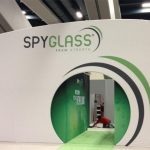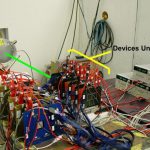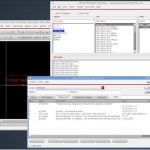When you think Apache Design you probably think Low Power Design and what stuffed animal will they give away at DAC. The other thing you should think about is how the top semiconductor companies around the world use Apache products for leading edge semiconductor design. Demos are fine, but there is nothing like talking directly to designers who use the tools in an intimate setting (20 people). You definitely do not want to miss this opportunity to collaborate but space is limited so register now:
Experience Sharing by Customers: At-a-Glance
Design experts from AMD, ARM, Freescale, LSI, Nvidia, Samsung, and STMicroelectronics will share best practices and in-depth experiences on how they successfully achieve power, performance,reliability, and cost targets.
AMD: Unified Method for Package-Induced Power Supply Droop Analysis in High Performance Processors:
Excessive supply voltage droop can have a significant impact on the clock frequency of high-performance processors. In this work we present a unique approach for power supply droop analysis. A detailed model of the package extracted from layout is combined with a representative model of the IC to simulate dynamic supply voltage gradients across the die. The IC model is geared towards accurate prediction of voltages on power supply C4 bumps. At the same time, it is compact enough to allow efficient simulation of the complete chip-package system. We used this methodology to simulate the droop on a high-performance server SoC. Dynamic simulations were performed with patterns exercising high-power sections of the CPU cores on the SoC. The simulated droops correlate very well with silicon characterizations performed on the same design. We discuss the use of this methodology in future for early analysis of chip/package systems and for driving both IC and package design decisions.
Main products covered: RedHawk
June 5 @ 11:00
To Register
ARM: Comprehensive Power, Noise and Reliability Methodology for ARM Processor Cores:
This presentation will discuss power integrity analysis of Seahawk hard macro, a Quad-core Cortex-A15 implemented in the TSMC 28 hpm process. Seahawk is designed to operate at frequencies close to 2-GHz and has DVFS and retention capabilities built-in. This presentation will describe the power integrity checks that were performed on the design to ensure proper functioning and reliability.
Main products covered: RedHawk
June 4 @ 11:00
To Register
Nvidia: Early RTL Power Analysis and Reduction for Advanced Low-Power GPU Designs:
This presentation covers Nvidia’s methodology for RTL power analysis and reduction using PowerArtist. Data on PowerArtist RTL power correlation vs. sign-off tools will be presented along with runtime performance metrics. Material will also include reports generated using the PowerArtist OADB database API, specific examples of power reduction techniques applied and results achieved, as well as key clock gating coverage and efficiency metrics. In conclusion, this presentation will show key benefits Nvidia achieved with PowerArtist and highlight areas where Nvidia and Apache are collaborating to advance RTL power technology in PowerArtist.
Main products covered: PowerArtist
June 3 @ 11:00
To Register
Samsung-SSI: The Life of PI: SoC Power Integrity from Early Estimation to Design Sign-off:
The life of Power Integrity (PI) analysis starts at the product infancy stage. Early analysis involves resource allocation at the system level, such as the VRM, board, and package, and at the chip level, in terms of power grid structure, power scenario analysis, and the amount and placement of intentional decoupling capacitance (DECAP). This is done through systematic PI modeling and simulation. As the design matures, the power integrity engineer gets more information on the system and on the die. There are many phases of progressive iterations to evaluate design tradeoffs. Power integrity engineers work closely with board, package, and chip design teams to achieve PI closure. At the design tape out stage, the power integrity team is responsible for signing off static and dynamic IR drop and EM to verify that multi-million gates SoC chips meet stringent power supply noise budget. We investigated the impact of board, package, package embedded with DECAP, power grid, circuit switching activity, as well as on-die DECAP and demonstrated good correlation between early estimation and the final analysis with detailed chip and package models.
Main products covered: RedHawk
June 3 @ 14:00
To Register
STMicroelectronics: RTL Power Estimation on ARM Core Sub-systems:
I will start my presentation with an introduction about High Performance Power Efficient ARM Cores implementation within ST and the associated challenge of estimating dynamic power early in the implementation flow. Then I’ll present results obtained when benchmarking PowerArtist tool by measuring accuracy versus signoff power figures on a Dual-cortex A9 subsystem. I will pursue by explaining how we have used PowerArtist tool on a Dual-Cortex A15 subsystem and the different results we have obtained. Finally, I’ll finish my presentation with a conclusion on the benefits of PowerArtist tool.
Main products covered: PowerArtist
June 4 @ 14:00
To Register
GlobalFoundries: Hierarchical Voltage Drop Analysis Techniques for Complex Power-Gated Multi-Domain 20nm Designs:
When qualifying new technologies for new design nodes (e.g. 20nm, 14nm…), large SRAM arrays with many power domainsare employed. Since the VMIN characterization of bit cells performed on silicon requires a sufficient power/ground network, an IR drop analysis at the transistor-level for the whole design is required. This presentation will cover a hierarchical IR drop analysis flow using new capabilities within Totem to trace networks of multi power domains (>800) through switch cells, and to generate subblock abstracts for different detail levels. The abstracts can then be used for top-level analysis; allowing a large speed-up of IR drop analysis in comparison to flat analysis. This presentation also includes a discussion about the pros and cons of the approach and will present resource requirements (run time, memory).
Main products covered: RedHawk,Totem
June 4 @ 12:00
To Register
Nvidia: Comprehensive Layout-based ESD Check Methodology with Fast, Full-chip Static and Macro-levelDynamic Solutions:
This presentation will discuss a comprehensive ESD static/dynamic methodology developed for pre-tapeout ESD verification, failure diagnosis, and predictive simulation of improvements. The methodology focuses on fast, full-chip static and macro-level dynamic analysis and will feature real HBM and CDM application examples. We will also discuss the potential impact of upcoming technologies on ESD including 3D-ICs, FinFETs, and system-level trade-offs.
Main products covered: PathFinder
June 5 @ 10:00
To Register
Freescale: Power, Noise and Reliability Simulation Consideration for Advanced Automotive and NetworkingICs:
This presentation covers experiences of SoCs for Automotive and Networking Applications. Due to the nature of theirapplication domains these ASICs bring different challenges and requirements. This presentation will discuss both Wire-Bond Chips with Low Cost Packaging requirements, as well as high cost Flip-Chip/BGA designs. Instead of discussing typical Power and Rail Analysis details, this presentation will focus on insights gathered from running analysis and silicon results, and will include Power Analysis (RTL and Gate-level), Rail Analysis (Static and Dynamic), handling complicated IPs/Std cells, ESD Sign-off and Cell Electro-migration analysis.
Main products covered: PowerArtist, RedHawk, Totem, PathFinder
June 3 @ 13:00
To Register
LSI: Chip and I/O Modeling for System-level Power Noise Analysis and Optimization:
The system level methodology proposed in this presentation encompasses die, package and PCB interconnects exposing the impact of the capacitive and mutual coupling enabled outside the silicon on the PLL supply. The proposed methodology allows selecting the best package routing solution for PLL supply noise reduction. Correlation with PG noise and jitter lab measurements confirms that our Sentinel-SSO based methodology is critically instrumental in intercepting PLL supply noise due to independently supplied I/O cells switching activity.
Main products covered: CPM, Sentinel, SIwave
June 4 @ 15:00
To Register
Apache Design is a subsidiary of ANSYS, Inc., a leading engineering simulation software provider. Our virtual prototyping technology has enabled customers to predict with confidence that their product designs will thrive in the real world. The extensive ANSYS product suite offers the ability to perform comprehensive multiphysics analyses, critical for high-fidelity simulation of real architecture that integrates varied components.
Apache power analysis and optimization solutions enable design of power-efficient, high-performance, noise-immune ICs and electronic systems. This comprehensive suite of integrated products and methodologies advances low-power innovation and provides a competitive advantage for the world’s top semiconductor companies to help lower power consumption, increase operating performance, reduce system cost, mitigate design risks, and shorten time-to-market for a broad range of end-markets and applications.
Apache technology complements and expands the breadth, depth, functionality, usability and interoperability of ANSYS simulation products. Our combined tools open the door to more comprehensive systems simulation so that engineers can predict product behavior much earlier in the design cycle.
Return to Main Apache @ DAC Page
lang: en_US










